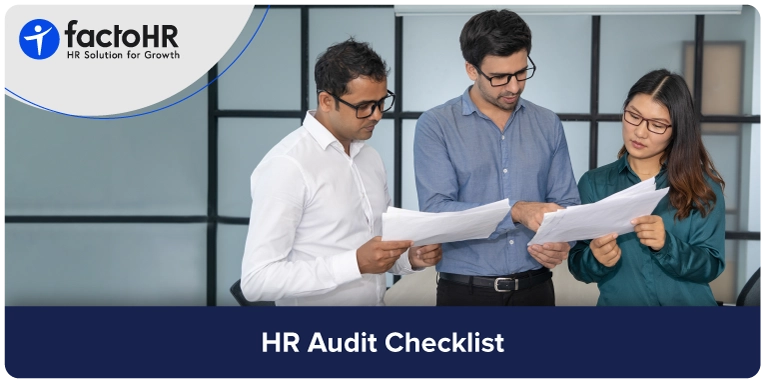How to Create an Effective HR Audit Checklist Template: A Comprehensive Guide

Table of Contents
Daily HR audits are essential because they help ensure that HR follows all the rules and avoids legal problems. Regular audits catch issues early and help keep everything on track. A good HR audit checklist makes these audits more effortless and effective.
In the sections below, you’ll learn what should be included in an HR audit checklist template and why having a good checklist for these audits is essential. This will help ensure that HR works correctly and stays within the law.
HR Audit Checklist Template
- Ensure job descriptions are up-to-date and accurate to the organization’s goals and work.
- Ensure there is no discrimination, and the hiring procedures must be legal. Legal innovations such as background checks are acceptable.
- Incorporate proper and formal methods of introducing new employees into the organization.
- Keep employee files complete, accessible, and secure.
- Ensure accurate and compliant payroll processes.
- Use effective performance appraisal systems and conduct regular reviews.
- Establish clear communication channels and conflict resolution procedures.
- Provide relevant training and evaluate its effectiveness regularly.
- Comply with various laws regarding employment practices and perform check-ups of the company’s labor law compliance.

Importance of HR Audit Checklist Template
HR audits are critical in looking for problems or areas that could be more efficient in practicing HRM. They also assist in labor law compliance, increasing employees’ morale and organizational performance. The HR audit checklist template helps you find areas that need improvement. This reduces legal issues and helps create a better and more organized workplace.
Pre-Audit Preparation
Setting Audit Objectives
Objectives must be defined before embarking on an audit. The goals of the HR audit help create a plan for what to check. This plan guides the auditor in examining important areas and ensuring everything is reviewed. Some objectives might be compliance checks, process optimization, and performance optimization.
Gathering Necessary Documents
This means collecting important papers about employees, including their personal records, company rules, pay details, and training papers. Such documents facilitate the audit process and avoid many interruptions.
Recruitment and Hiring Practices
Background Checks and References
Ensure that background and reference checks are done correctly and follow the rules. This will help in hiring trustworthy and qualified employees.
Onboarding Procedures
Check how well new workers are getting settled into the job. A good onboarding process helps keep workers longer and helps them do their jobs better.
Employee Records and Documentation
Employee Files and Documentation
Make sure all employee files are complete, organized, and easy to find. Good records help meet the legal laws and keep the hiring process running smoothly.
Record Keeping Compliance
Keep all records as the law says, ensuring they are kept private for the right time.
Data Privacy and Security
Ensure that employee data is well secured through proper measures. This includes protection against attacks such as data breaches and achieving data privacy.

Compensation and Benefits
Scale of Salary and Remuneration Schemes
Standardize pay scales to maintain relevant and fair remuneration. This will help with hiring by ensuring the company has many skilled workers.
Payroll Processes and Compliance
Make sure the payroll follows the rules so that salaries are paid correctly and on time.
Performance Management
Performance Appraisal Systems
Check that performance appraisal systems are effective and align with organizational goals. This includes regular reviews and feedback mechanisms.
Goal Setting and Feedback
Tell employees what goals they need to reach and give them regular feedback to help them improve.
Employee Relations and Engagement
Employee Communication Channels
Rate the extent of communication between employees and top management. An open communication channel is healthy for the organization and its employees.
Conflict Resolution Procedures
Ensure that suitable measures can be taken to solve the conflicts that one may have with the employees.

Training and Development
Training Programs and Initiatives
Evaluate the usage and efficiency of training activities. Ongoing training helps employees learn about new trends and improve the company.
Skill Development and Career Growth
Verify that skill development programs are aligned with employees’ career growth aspirations.
Health and Safety Compliance
Workplace Safety Policies
Follow workplace safety policies, include all necessary indications, and match the legal requirements.
Incident Reporting and Investigation
Ensure there are steps for reporting problems and that they are handled well for safety.
Employee Health Programs
Check health programs to ensure they follow the rules and help keep workers healthy.
Legal and Regulatory Compliance
Employment Law Compliance
Ensure that all the legal requirements regarding employment have been adhered to in the organization.
Equal Employment Opportunity
Confirm there is no discrimination based on race, gender, or anything else at work.
Labor Relations and Union Agreements
Review labor and union agreements to make sure they are fair and follow the legal rules.
Post-Audit Activities
Analyzing Audit Findings
Review audit results to determine where changes are needed and the rules are not followed.
Reporting Results to Management
Write down what you find during the audit and make reports with suggestions for the management.
Implementing Corrective Actions
Correct the problems shown by the audit results. Update HR processes to make them better and more effective.
Conclusion
Regular HR audits are essential. They help the organization follow the rules and work well. Using an HR audit checklist template helps an organization improve its HR work and create a pleasing workplace.
The above practices help reduce risks, increase employee satisfaction, and promote a culture of compliance and excellence.

FAQs
What is the HR Audit Checklist Template?
The HR audit checklist template is a tool for examining an organization’s personnel records, past or present, to verify compliance with the legal requirements established for human resources policies and procedures.
What Are the Features of an HR Audit?
HR audits include compliance assessment, gap identification, improving employees’ satisfaction, and increasing the organization’s effectiveness.
What is the frequency of the HR audits?
HR audits should be conducted at least once a year as part of the organization’s ongoing efforts.
What Are the Objectives of an HR Audit?
An HR audit can be used for compliance, to analyze the current process and its improvement, or to evaluate performance.
Grow your business with factoHR today
Focus on the significant decision-making tasks, transfer all your common repetitive HR tasks to factoHR and see the things falling into their place.

© 2025 Copyright factoHR


